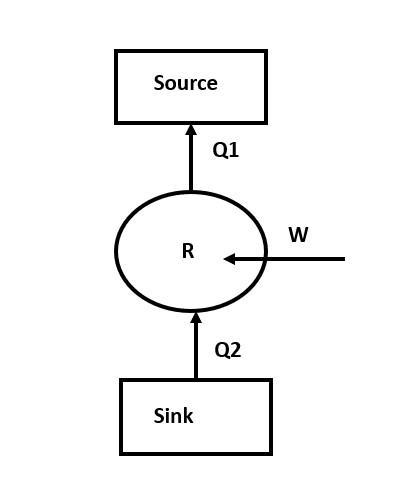
The temperature inside and outside of a refrigerator are $275 $ K and $300$ K, respectively. Assuming that the refrigerator cycle is ideal reversible, for every joule of work done the heat delivered to the surroundings is nearly.
a) $10 J$
b) $11 J$
c) $14 J$
d) $12 J$
Answer
518.7k+ views
Hint: The working substance absorbs some amount of heat from the sink which is at the lower temperature, then W is the work which is done on the working substance and then some amount of heat rejected by the working substance to the surroundings. This is the basic principle of refrigerators.
Complete step by step answer:
Given inside temperature (sink temperature), $T_{2}=275 K$
Outside temperature (source temperature), $T_{1}=300K$
Work done = $1 J$
R is the refrigerator.
Assume: Refrigerator is ideal and reversible. So, we can write:
$\dfrac{ Q_{1}}{ Q_{2}} = \dfrac{ T_{1}}{ T_{2}}$

We have to find the heat lost to the surroundings, $ Q_{1}$.
Coefficient of performance -
$B = \dfrac{ Q_{2}}{W}$
Now, we will write B in terms of the temperatures.
$B = \dfrac{ T_{2}}{ T_{1}- T_{2}}$
$B = \dfrac{ 275}{ 300- 275} =11$
By using, formula of coefficient of performance, we can evaluate: -
$B = \dfrac{ Q_{2}}{W}$
Now, we will put the value of W.
$10 = \dfrac{ Q_{2}}{1}$
$ Q_{2} = 10 j$
By using the value of work, we can calculate $ Q_{1}$.
$W = Q_{1} - Q _{2}$
$Q_{1} = W + Q _{2}$
$Q_{1} = 1 + 10 = 11 J$
So, the heat delivered to the surroundings = $11 J$.
So, the correct answer is “Option b”.
Note: The heat flow follows the first law of thermodynamics. Work has to be done, otherwise heat will not flow from low temperature to high temperature and violates the second law of thermodynamics. In the refrigerator, heat is rejected to surroundings and entropy is increased.
Complete step by step answer:
Given inside temperature (sink temperature), $T_{2}=275 K$
Outside temperature (source temperature), $T_{1}=300K$
Work done = $1 J$
R is the refrigerator.
Assume: Refrigerator is ideal and reversible. So, we can write:
$\dfrac{ Q_{1}}{ Q_{2}} = \dfrac{ T_{1}}{ T_{2}}$

We have to find the heat lost to the surroundings, $ Q_{1}$.
Coefficient of performance -
$B = \dfrac{ Q_{2}}{W}$
Now, we will write B in terms of the temperatures.
$B = \dfrac{ T_{2}}{ T_{1}- T_{2}}$
$B = \dfrac{ 275}{ 300- 275} =11$
By using, formula of coefficient of performance, we can evaluate: -
$B = \dfrac{ Q_{2}}{W}$
Now, we will put the value of W.
$10 = \dfrac{ Q_{2}}{1}$
$ Q_{2} = 10 j$
By using the value of work, we can calculate $ Q_{1}$.
$W = Q_{1} - Q _{2}$
$Q_{1} = W + Q _{2}$
$Q_{1} = 1 + 10 = 11 J$
So, the heat delivered to the surroundings = $11 J$.
So, the correct answer is “Option b”.
Note: The heat flow follows the first law of thermodynamics. Work has to be done, otherwise heat will not flow from low temperature to high temperature and violates the second law of thermodynamics. In the refrigerator, heat is rejected to surroundings and entropy is increased.
Recently Updated Pages
Why are manures considered better than fertilizers class 11 biology CBSE

Find the coordinates of the midpoint of the line segment class 11 maths CBSE

Distinguish between static friction limiting friction class 11 physics CBSE

The Chairman of the constituent Assembly was A Jawaharlal class 11 social science CBSE

The first National Commission on Labour NCL submitted class 11 social science CBSE

Number of all subshell of n + l 7 is A 4 B 5 C 6 D class 11 chemistry CBSE

Trending doubts
What is meant by exothermic and endothermic reactions class 11 chemistry CBSE

10 examples of friction in our daily life

One Metric ton is equal to kg A 10000 B 1000 C 100 class 11 physics CBSE

1 Quintal is equal to a 110 kg b 10 kg c 100kg d 1000 class 11 physics CBSE

Difference Between Prokaryotic Cells and Eukaryotic Cells

What are Quantum numbers Explain the quantum number class 11 chemistry CBSE




